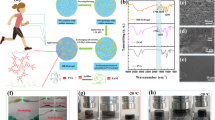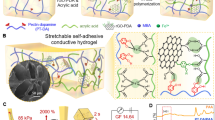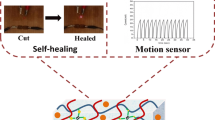Abstract
Conductive hydrogels have attracted enormous attention in wearable electronic devices due to considerable flexibility and similarity with human skin. Since the majority of hydrogels were fabricated by one-pot method alone and the conductivity change under strain was caused by the slight shape change and the fixed conductive path, further improvement of the sensitivity is hard. Thus, we cast the silver nanowires (AgNW) in ethanol solvent on the upper surface of polyacrylic acid/chitosan (PAA/CS) hydrogels prepared by one-pot method to obtain asymmetrical PAA/CS@AgNW hydrogels. As the construction of conductive surface, the ethanol gradually diffused into the hydrogel and caused the upper surface with ideal wrinkle structure. Thanks to the dual-effect of the design, the sensitivity was greatly enhanced with the ultra-high gauge factor (GF = 191.2, 7413, 18,720) at different pressure ranges. A series of reliable application performance (flexibility, self-healing, dry resistance and adhesion) and excellent electrical signal response (ultra-high sensitivity, identification, repetition and stability) was tested and indicated the potential applications in motion detection, gesture recognition and health monitoring.





Similar content being viewed by others
References
Azadi S, Peng SH, Moshizi SA, Asadnia M, Xu JT, Park I, Wang CH, Wu SY (2020) Biocompatible and highly stretchable PVA/AgNW hydrogel strain sensors for human motion detection. Adv Mater Technol 5:2000426–2000437. https://doi.org/10.1002/admt.202000426
Bai L, Jin Y, Shang X, Shi L, Jin H, Zhou R, Lai S (2022) Bio-inspired visual multi-sensing interactive ionic skin with asymmetrical adhesive, antibacterial and self-powered functions. Chem Eng J. https://doi.org/10.1016/j.cej.2022.135596
Bai L, Jin Y, Shang X, Shi L, Jin H, Zhou R, Lai S (2022) Bio-inspired visual multi-sensing interactive ionic skin with asymmetrical adhesive, antibacterial and self-powered functions. Chem Eng J. https://doi.org/10.1016/j.cej.2022.135596
Chen MZ, Dong Y, Zhou XY (2022) Progress in preparation and application of anisotropic cellulose-based hydrogels. J Forestry Eng 7:20–30. https://doi.org/10.13360/j.issn.2096-1359.202107004
Chen Y, Lu K, Song Y, Han J, Yue Y, Biswas SK, Wu Q, Xiao H (2019) A skin-Inspired stretchable, self-Healing and slectro-conductive hydrogel with a synergistic triple network for wearable strain sensors applied in human-motion detection. Nanomaterials (Basel). https://doi.org/10.3390/nano9121737
Cui C, Wu T, Chen X, Liu Y, Li Y, Xu Z, Fan C, Liu W (2020) A Janus hydrogel wet adhesive for internal tissue repair and anti-postoperative adhesion. Adv Funct Mater. https://doi.org/10.1002/adfm.202005689
Cui C, Wu T, Chen X, Liu Y, Li Y, Xu Z, Fan C, Liu W (2020) A Janus hydrogel wet adhesive for internal tissue repair and anti-postoperative adhesion. Adv Funct Mater. https://doi.org/10.1002/adfm.202005689
Cui C, Wu T, Chen X, Liu Y, Li Y, Xu Z, Fan C, Liu W (2020) A Janus hydrogel wet adhesive for internal tissue repair and anti-postoperative adhesion. Adv Funct Mater. https://doi.org/10.1002/adfm.202005689
Cui C, Wu T, Chen X, Liu Y, Li Y, Xu Z, Fan C, Liu W (2020) A Janus hydrogel wet adhesive for internal tissue repair and anti-postoperative adhesion. Adv Funct Mater. https://doi.org/10.1002/adfm.202005689
Fu F, Wang J, Yu J (2021) Interpenetrating PAA-PEDOT conductive hydrogels for flexible skin sensors. J Mater Chem C 9:11794–11800. https://doi.org/10.1039/d1tc01578h
Gao G, Yang F, Zhou F, He J, Lu W, Xiao P, Yan H, Pan C, Chen T, Wang ZL (2020) Bioinspired self-healing human-machine interactive touch pad with pressure-sensitive adhesiveness on targeted substrates. Adv Mater 32:e2004290. https://doi.org/10.1002/adma.202004290
Gong XX, Fei GT, Fu WB, Fang M, Gao XD, Zhong BN, Zhang LD (2017) Flexible strain sensor with high performance based on PANI/PDMS films. Org Electron 47:51–56. https://doi.org/10.1016/j.orgel.2017.05.001
Gu JF, Huang JR, Chen GQ, Hou LX, Zhang J, Zhang X, Yang XX, Guan LH, Jiang XC, Liu HY (2020) Multifunctional poly(vinyl alcohol) nanocomposite organohydrogel for flexible strain and temperature sensor. Acs Appl Mater Inter 12:40815–40827. https://doi.org/10.1021/acsami.0c12176
Han JQ, Lu KY, Yue YY, Mei CT, Huang CB, Wu QL, Xu XW (2019) Nanocellulose-templated assembly of polyaniline in natural rubber-based hybrid elastomers toward flexible electronic conductors. Ind Crop Prod 128:94–107. https://doi.org/10.1016/j.indcrop.2018.11.004
Han S, Liu C, Lin X, Zheng J, Wu J, Liu C (2020) Dual conductive network hydrogel for a highly conductive, self-healing, anti-freezing, and non-drying strain sensor. Acs Appl Polym Mater 2:996–1005. https://doi.org/10.1021/acsapm.9b01198
He Z, Yuan W (2021) Adhesive, stretchable, and transparent organohydrogels for antifreezing, antidrying, and sensitive ionic skins. ACS Appl Mater Interfaces 13:1474–1485. https://doi.org/10.1021/acsami.0c18405
Henn D, Fischer KS, Chen K, Greco AH, Martin RA, Sivaraj D, Trotsyuk AA, Mao HQ, Reddy SK, Kneser U, Gurtner GC, Schmidt VJ, Sacks JM (2022) Enrichment of nanofiber hydrogel composite with fractionated fat promotes regenerative macrophage polarization and vascularization for soft-tissue engineering. Plast Reconstr Surg 149:433e–444e. https://doi.org/10.1097/PRS.0000000000008872
Hu JQ, Wu YL, Yang Q, Zhou QW, Hui LF, Liu Z, Xu F, Ding DY (2022) One-pot freezing-thawing preparation of cellulose nanofibrils reinforced polyvinyl alcohol based ionic hydrogel strain sensor for human motion monitoring. Carbohyd Polym 275:118697–118708. https://doi.org/10.1016/j.carbpol.2021.118697
Huang B, Lin FC, Tang LR, LU QL, LU BL (2022) Research advances of functional cellulose-based hydrogels and its applications. J For Eng 7:1–13. https://doi.org/10.13360/j.issn.2096-1359.202111033
Huang JR, Gu JF, Liu JT, Guo JQ, Liu HY, Hou K, Jiang XC, Yang XX, Guan LH (2021) Environment stable ionic organohydrogel as a self-powered integrated system for wearable electronics. J Mater Chem A 9:16345–16358. https://doi.org/10.1039/d1ta03618a
Huang JR, Peng SJ, Gu JF, Chen GQ, Gao JH, Zhang J, Hou LX, Yang XX, Jiang XC, Guan LH (2020) Self-powered integrated system of a strain sensor and flexible all-solid-state supercapacitor by using a high performance ionic organohydrogel. Mater Horiz 7:2085–2096. https://doi.org/10.1039/d0mh00100g
Izawa H, Kaneko Y, Kadokawa J (2009) Unique gel of xanthan gum with ionic liquid and its conversion into high performance hydrogel. J Mater Chem 19:6969–6972. https://doi.org/10.1039/b916864h
Jiao Y, Lu KY, Lu Y, Yue YY, Xu XW, Xiao HN, Li J, Han JQ (2021a) Highly viscoelastic, stretchable, conductive, and self-healing strain sensors based on cellulose nanofiber-reinforced polyacrylic acid hydrogel. Cellulose 28:4295–4311. https://doi.org/10.1007/s10570-021-03782-1
Jiao Y, Lu Y, Lu K, Yue Y, Xu X, Xiao H, Li J, Han J (2021b) Highly stretchable and self-healing cellulose nanofiber-mediated conductive hydrogel towards strain sensing application. J Colloid Interface Sci 597:171–181. https://doi.org/10.1016/j.jcis.2021.04.001
Jing X, Wang XY, Mi HY, Turng LS (2019) Stretchable gelatin/silver nanowires composite hydrogels for detecting human motion. Mater Lett 237:53–56
Li L, Zhao Q, Wen HK, Jiang JX, Liu LJ, Duan JF (2021) Preparation and performance of galactomannan temperature-sensitive hydrogels. J For Eng 6:120–127. https://doi.org/10.13360/j.issn.2096-1359.202103030
Lu F, Wang Y, Wang C, Kuga S, Huang Y, Wu M (2020) Two-dimensional nanocellulose-enhanced high-strength, self-adhesive, and strain-sensitive poly(acrylic acid) hydrogels fabricated by a radical-induced strategy for a skin Ssensor. ACS Sustain Chem Eng 8:3427–3436. https://doi.org/10.1021/acssuschemeng.9b07467
Lu J, Gu JF, Hu OD, Fu YH, Ye DZ, Zhang X, Zheng Y, Hou LX, Liu HY, Jiang XC (2021) Highly tough, freezing-tolerant, healable and thermoplastic starch/poly(vinyl alcohol) organohydrogels for flexible electronic devices. J Mater Chem A 9:18406–18420. https://doi.org/10.1039/d1ta04336f
Lu Y, Yue Y, Ding Q, Mei C, Xu X, Wu Q, Xiao H, Han J (2021) Self-recovery, fatigue-resistant, and multifunctional sensor assembled by a nanocellulose/carbon nanotube nanocomplex-mediated hydrogel. ACS Appl Mater Interfaces 13:50281–50297. https://doi.org/10.1021/acsami.1c16828
Ma D, Wu XX, Wang YG, Liao H, Wan PB, Zhang LQ (2019) Wearable, antifreezing, and healable epidermal sensor assembled from long-lasting moist conductive nanocomposite organohydrogel. Acs Appl Mater Inter 11:41701–41709. https://doi.org/10.1021/acsami.9b15412
Madni A, Kousar R, Naeem N, Wahid F (2021) Recent advancements in applications of chitosan-based biomaterials for skin tissue engineering. J Bioresour Bioprod 6:11–25. https://doi.org/10.1016/j.jobab.2021.01.002
Mandal B, Rameshbabu AP, Soni SR, Ghosh A, Dhara S, Pal S (2017) In situ silver nanowire deposited cross-linked carboxymethyl cellulose: a potential transdermal anticancer drug carrier. Acs Appl Mater Inter 9:36583–36595. https://doi.org/10.1021/acsami.7b10716
Mao J, Zhao C, Li Y, Xiang D, Wang Z (2020) Highly stretchable, self-healing, and strain-sensitive based on double-crosslinked nanocomposite hydrogel. Compos Commun 17:22–27. https://doi.org/10.1016/j.coco.2019.10.007
Nie K, Wang Z, Tang R, Zheng L, Li C, Shen X, Sun Q (2020) Anisotropic, flexible wood hydrogels and wrinkled, electrodeposited film electrodes for highly sensitive, wide-range pressure sensing. ACS Appl Mater Interfaces 12:43024–43031. https://doi.org/10.1021/acsami.0c13962
Pan W, Wang J, Li YP, Sun XB, Wang JP, Wang XX, Zhang J, You HD, Yu GF, Long YZ (2020) Facile preparation of highly stretchable TPU/Ag nanowire strain sensor with spring-like configuration. Polymers-Basel 12:339–352. https://doi.org/10.3390/polym12020339
Pan X, Wang Q, Guo R, Ni Y, Liu K, Ouyang X, Chen L, Huang L, Cao S, Xie M (2019) An integrated transparent, UV-filtering organohydrogel sensor via molecular-level ion conductive channels. J Mater Chem A 7:4525–4535. https://doi.org/10.1039/c8ta12360h
Pan XF, Wang QH, Guo RS, Cao SL, Wu H, Ouyang XH, Huang F, Gao HL, Huang LL, Zhang F, Chen LH, Ni YH, Liu K (2020) An adaptive ionic skin with multiple stimulus responses and moist-electric generation ability. J Mater Chem A 8:17498–17506. https://doi.org/10.1039/c9ta13407g
Pan Z, Wang ZY, Wang MH, Yang L, Yu SH (2021) Adhesive aero-hydrogel hybrid conductor assembled from silver nanowire architectures. Sci China Mater 64:2868–2876. https://doi.org/10.1007/s40843-021-1677-3
Peng Y, Tang S, Wang X, Ran R (2021) A high strength hydrogel with a core–shell structure simultaneously serving as strain sensor and solar water evaporator. Macromol Mater Eng. https://doi.org/10.1002/mame.202100309
Sun CY, Hou CY, Zhang H, Li YG, Zhang QH, Wang HZ (2021) Ultra-stretchable, self-adhesive, transparent, and ionic conductive organohydrogel for flexible sensor. Apl Mater 9:011101–011111. https://doi.org/10.1063/5.0035996
Sun D, Li N, Rao J, Jia SY, Su ZH, Hao X, Peng F (2021) Ultrafast fabrication of organohydrogels with UV-blocking, anti-freezing, anti-drying, and skin epidermal sensing properties using lignin-Cu2 + plant catechol chemistry. J Mater Chem A 9:14381–14391. https://doi.org/10.1039/d1ta02139g
Sun HL, Zhao Y, Jiao SL, Wang CF, Jia YP, Dai K, Zheng GQ, Liu CT, Wan PB, Shen CY (2021) Environment tolerant conductive nanocomposite organohydrogels as flexible strain sensors and power sources for sustainable electronics. Adv Funct Mater 31:2101696–2101706. https://doi.org/10.1002/adfm.202101696
Taesuwan I, Ounkaew A, Okhawilai M, Hiziroglu S, Jarernboon W, Chindaprasirt P, Kasemsiri P (2022) Smart conductive nanocomposite hydrogel containing green synthesized nanosilver for use in an eco-friendly strain sensor. Cellulose 29:273–286. https://doi.org/10.1007/s10570-021-04302-x
Teixeira LSM, Feijen J, van Blitterswijk CA, Dijkstra PJ, Karperien M (2012) Enzyme-catalyzed crosslinkable hydrogels: Emerging strategies for tissue engineering. Biomaterials 33:1281–1290. https://doi.org/10.1016/j.biomaterials.2011.10.067
Wang DY, Qin L, Yang WH, He Y, Zhang SY, Yang YL, Xu K, Gao PF, Yu JX, Cai KY (2021) A conductive hydrogel based on galn and PVA/PAA/Fe3+ for strain sensor and physiological signal detection. Acs Appl Polym Mater 3:5268–5276. https://doi.org/10.1021/acsapm.1c01063
Wang J, Qu J, Liu YX, Wang S, Liu XL, Chen YP, Qi PY, Miao GH, Liu XF (2021b) “Crocodile skin” ultra-tough, rapidly self-recoverable, anti-dry, anti-freezing, MoS2-based ionic organohydrogel as pressure sensors. Colloid Surf A 625:126458–126468. https://doi.org/10.1016/j.colsurfa.2021b.126458
Wang LY, Daoud WA (2019) Hybrid conductive hydrogels for washable human motion energy harvester and self-powered temperature-stress dual sensor. Nano Energy. https://doi.org/10.1016/j.nanoen.2019.104080
Wang Q, Pan X, Lin C, Lin D, Ni Y, Chen L, Huang L, Cao S, Ma X (2019) Biocompatible, self-wrinkled, antifreezing and stretchable hydrogel-based wearable sensor with PEDOT:sulfonated lignin as conductive materials. Chem Eng J 370:1039–1047. https://doi.org/10.1016/j.cej.2019.03.287
Wang S, Li S, Li N, Wang C, Cui G, Yu L, Murto P, Xu X (2022) Design of double-network click-gels for self-contained underwater adhesion and energy-wise applications in floating photovoltaics. Adv Funct Mater. https://doi.org/10.1002/adfm.202201919
Wu L, Fan MS, Qu MJ, Yang ST, Nie J, Tang P, Pan LJ, Wang H, Bin YZ (2021a) Self-healing and anti-freezing graphene-hydrogel-graphene sandwich strain sensor with ultrahigh sensitivity. J Mater Chem B 9:3088–3096.https://doi.org/10.1039/d1tb00082a
Wu XX, Liao H, Ma D, Chao MY, Wang YG, Jia XL, Wan PB, Zhang LQ (2020) A wearable, self-adhesive, long-lastingly moist and healable epidermal sensor assembled from conductive MXene nanocomposites. J Mater Chem C 8:1788–1795. https://doi.org/10.1039/c9tc05575d
Wu Z, Yang X, Wu J (2021b) Conductive hydrogel- and -oganohydrogel-based stretchable sensors. ACS Appl Mater Interfaces 13:2128–2144. https://doi.org/10.1021/acsami.0c21841
Xia S, Song SX, Li Y, Gao GH (2019) Highly sensitive and wearable gel-based sensors with a dynamic physically cross-linked structure for strain-stimulus detection over a wide temperature range. J Mater Chem C 7:11303–11314. https://doi.org/10.1039/c9tc03475g
Xie C, Wang X, He H, Ding Y, Lu X (2020) Mussel-inspired hydrogels for self-adhesive bioelectronics. Adv Funct Mater 30:1909954–1909983. https://doi.org/10.1002/adfm.201909954
Yang C, Yin J, Chen Z, Du H, Tian M, Zhang M, Zheng J, Ding L, Zhang P, Zhang X, Deng K (2020) Highly conductive, stretchable, adhesive, and self-healing polymer hydrogels for strain and pressure sensor. Macromol Mater Eng 305. https://doi.org/10.1002/mame.202000479
Yin JY, Pan SX, Wu LL, Tan LYN, Chen D, Huang S, Zhang YH, He PX (2020) A self-adhesive wearable strain sensor based on a highly stretchable, tough, self-healing and ultra-sensitive ionic hydrogel. J Mater Chem C 8:17349–17364. https://doi.org/10.1039/d0tc04144k
Zhang L, Wang J, Wang SW, Wang LL, Wu MH (2022) Neuron-inspired multifunctional conductive hydrogels for flexible wearable sensors. J Mater Chem C 4327–4335. https://doi.org/10.1039/d1tc05864a
Zhang XJ, Zhang YC, Zhang WL, Dai Y, Xia F (2021) Gold nanoparticles-deranged double network for Janus adhesive-tough hydrogel as strain sensor. Chem Eng J 420. https://doi.org/10.1016/j.cej.2021.130447
Zhang YL, Guo X, Wang W, Chen L, Liu L, Liu H, He Y (2020) Highly sensitive, low hysteretic and flexible strain sensor based on ecoflex-agnws- mwcnts flexible composite materials. Ieee Sens J 20:14118–14125. https://doi.org/10.1109/Jsen.2020.3008159
Zhao L, Huang JH, Zhang YC, Wang T, Sun WX, Tong Z (2017) Programmable and bidirectional bending of soft actuators based on janus structure with sticky tough paa-clay hydrogel. Acs Appl Mater Inter 9:11866–11873. https://doi.org/10.1021/acsami.7b00138
Zheng C, Lu K, Lu Y, Zhu S, Yue Y, Xu X, Mei C, Xiao H, Wu Q, Han J (2020) A stretchable, self-healing conductive hydrogels based on nanocellulose supported graphene towards wearable monitoring of human motion. Carbohydr Polym 250:116905. https://doi.org/10.1016/j.carbpol.2020.116905
Zheng S, Li W, Ren Y, Liu Z, Zou X, Hu Y, Guo J, Sun Z, Yan F (2021) Moisture-wicking, breathable and intrinsically antibacterial electronic skin based on dual gradient poly(ionic liquid) nanofiber membranes. Adv Mater. https://doi.org/10.1002/adma.202106570
Zheng T, Abadi PPSS, Seo J, Cha BH, Miccoli B, Li YC, Park K, Park S, Choi SJ, Bayaniahangar R, Zhang DX, Lee SH, Lee CK, Khademhosseini A, Shin SR (2019) Biocompatible carbon nanotube-based hybrid microfiber for implantable electrochemical actuator and flexible electronic applications. Acs Appl Mater Inter 11:20615–20627. https://doi.org/10.1021/acsami.9b02927
Zhou X, Hu C, Lin X, Han X, Zhao X, Hong J (2021) Polyaniline-coated cotton knitted fabric for body motion monitoring. Sens Actuators A Phys 321:112591–112601. https://doi.org/10.1016/j.sna.2021.112591
Funding
This work was supported by the Fundamental Research Funds for the Central Universities (No. 22322022G-03).
Author information
Authors and Affiliations
Contributions
All authors contributed to the study conception and design. Material preparation, data collection and analysis were performed by Yu Jiang, Wanqi Feng, Yixiang Chen and Jie Gu. The first draft of the manuscript was written by Yu Jiang and all authors commented on previous versions of the manuscript. All authors read and approved the final manuscript.
Corresponding author
Ethics declarations
Conflict of interest
The authors have no relevant financial or non-financial interests to disclose.
Additional information
Publisher’s Note
Springer Nature remains neutral with regard to jurisdictional claims in published maps and institutional affiliations.
Rights and permissions
Springer Nature or its licensor holds exclusive rights to this article under a publishing agreement with the author(s) or other rightsholder(s); author self-archiving of the accepted manuscript version of this article is solely governed by the terms of such publishing agreement and applicable law.
About this article
Cite this article
Jiang, Y., Feng, W., Chen, Y. et al. Adhesive conductive hydrogels with wrinkled Janus surface and ultra-high sensitivity used as strain sensors. Cellulose 29, 9297–9309 (2022). https://doi.org/10.1007/s10570-022-04846-6
Received:
Accepted:
Published:
Issue Date:
DOI: https://doi.org/10.1007/s10570-022-04846-6




